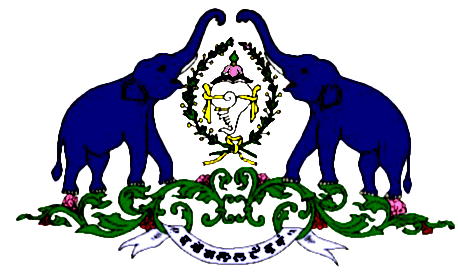TRAVANCORE

BRIEF HISTORY
Europeans were attracted to the region during the late fifteenth century, primarily in pursuit of the then rare commodity, pepper. The Portuguese were the first to arrive, followed by their later rivals, the Dutch, during the seventeenth century.
Following the failure of the senior Kolatbunad matrilineal line, two sisters were adopted from the Kolathunadu house in 1749. The succession has continued in the female line of that family ever since.
Raja Martanda Varma I is judged as one of the greatest and most able rulers of the state. He expanded his domains by annexing several petty principalities and reducing the powers of his vassals. Extremely devout, he surrendered the realm to Sri Padmanabha (Vishnu), thereafter ruling as a deputy or representative of the deity on earth. His nephew and successor, Rama Varma, consolidated his inheritance and kept Hyder ‘Ali and Tipu Sultan of Mysore at bay. He encouraged poets and musicians and patronised the arts to the end of his long, forty-year, reign.
Rama Varm’s successors entered into an alliance with the British in response to the threats to their independence from Tipu Sultan. A British resident was appointed to the court and a modern military force established. The Nayyar Brigade served with distinction in many of the campaigns in South India, during the early nineteenth century.
Raja Pala Rama Varma III, who ascended the throne in 1813, has an unrivalled reputation as a scholar, composer and polyglot. Great advances in education, medicine, industry and welfare were made during the Sri Rama Varma VI (r. 1885-1924) and Bala Rama Varma II (r. 1924-1971). They selected the very best administrators from all over India to fill positions in the government. By the advent of India independence, the state had achieved an envied place as a model government. Many reforms, especially those in the fields of education, religious toleration, and advances of the lower castes, being ahead of the rest of the country.
The reigning Maharaja and his gifted Chief Minister were not at all keen on seeing their state absorbed into the greater mass of India. After two years of prevarication, union with the neighbouring state of Cochin was affected with a good deal of arm-twisting and heavy-handed persuasion from the central government and apparent local "popular opinion". Maharaja Bala Rama Varma II remained a popular figure throughout, serving as Rajpramukh until the abolition of that post in 1956. Consequently, the absorption of the state into India proceeded at a pace somewhat slower than other parts of the country. His death in 1991, two decades after the abolition of princely titles and civil lists, was observed with an outpouring of grief. His younger brother, succeeded as Head of the Royal House.
Copyright© Christopher Buyers
SALUTE:
19-guns.
Copyright© Christopher Buyers
FLAG:
24’x12’ A rectangular red flag with a white conch in the centre.
Copyright© Christopher Buyers
STYLES & TITLES:
The ruling prince: Maharaja Raja Ramaraja Sri Patmanabha Dasa Vanchi Pala (personal name) Varma, Kulasekhara Kiritapati Manney Sultan Bahadur, Shamsher Jang, Maharaja of Travancore, with the style of His Highness.
The Heir Apparent: Maharajkumar (personal name) Varma, Eliya Raja of Travancore.
The Heiress: Sri Patmanabha Sevini Vanchi Dharma Vardhini Raja Rajeshwari Maharani (personal name) Bai, Senior Maharani of Travancore, with the style of Her Highness.
The Second Heiress, if mother of the ruling prince: Sri Patmanabha Sevini Vanchipala Dyumani Raj Rajeshwari Maharani Maharani (personal name) Bai, Junior Maharani of Travancore, with the style of Her Highness.
The consort of the ruling prince: (mother’s house name) Ammachi Panapilla Amma Srimathi (personal name) Pilla Kochamma.
The sons of the ruling prince: Sri (mother’s house name) (personal name) Tampi.
The daughters of the ruling prince: (mother’s house name) Ammaveetil Srimathi (personal name) Pilla Kochamma.
Copyright© Christopher Buyers
NB: all members of the ruling family receive two names, an official personal name and a name associated with the star under which they are born. The latter usually end with the suffix Tirunal.
Copyright© Christopher Buyers
RULES OF SUCCESSION:
The family follows the Marumakkathayam law of matrilineal inheritance, according to male primogeniture.
1. The surviving younger brothers of the Maharaja, according to age, and by the same mother.
2. The sons of the sisters of the Maharaja, according to age. The sons of elder sisters succeeded before those of the younger sisters.
3. The sons of the eldest maternal aunt of the Maharaja, according to age.
4. The sons of the daughters of the eldest maternal aunt of the Maharaja, according to age. The sons of elder daughters succeeded before those of the younger sisters.
Copyright© Christopher Buyers
The two senior Princesses of the Royal House, the mother of the Maharaja and her sister, received the principality of Attingal in appanage. They were consequently styled the Senior and Junior Rani of Attingal, respectively. Their husbands, known as Koil Tampurans, came from one of four or five royal houses (or ‘palaces’) who were closely related to the ruling family.
Copyright© Christopher Buyers
ORDERS & DECORATIONS:
None.
Copyright© Christopher Buyers
GLOSSARY:
Kiritapati: Possessor of the diadem.
Kulashekhara: Head (Shekhara) of the race (Kulam).
Mani Sultan: the Pearl of rulers.
Nal: "star", the usual suffix to the star name of a member of a junior princely family.
Shamsher Jang: Sword of War
Patmanabha Dasa: Servant of the lotus-navelled (i.e. Vishnu, the state deity).
Tampuran: Prince.
Tampuratti: Princess.
Tirunal: "star", the usual suffix to the star name of a member of the ruling house.
History of the Ruling Princes, Chiefs and Leading Personages in the Madras States, Govt. of India Press, New Delhi, 1941.
Copyright© Christopher Buyers
SPECIAL ACKNOWLEDGEMENT:
Colonel Anand Kumar.
John D. McMeekin.
Manu Pillai.
Radhakrishnan A Ramavarma.
Shree Kumar Varma.
Copyright©Christopher Buyers, December 2001 - October 2015